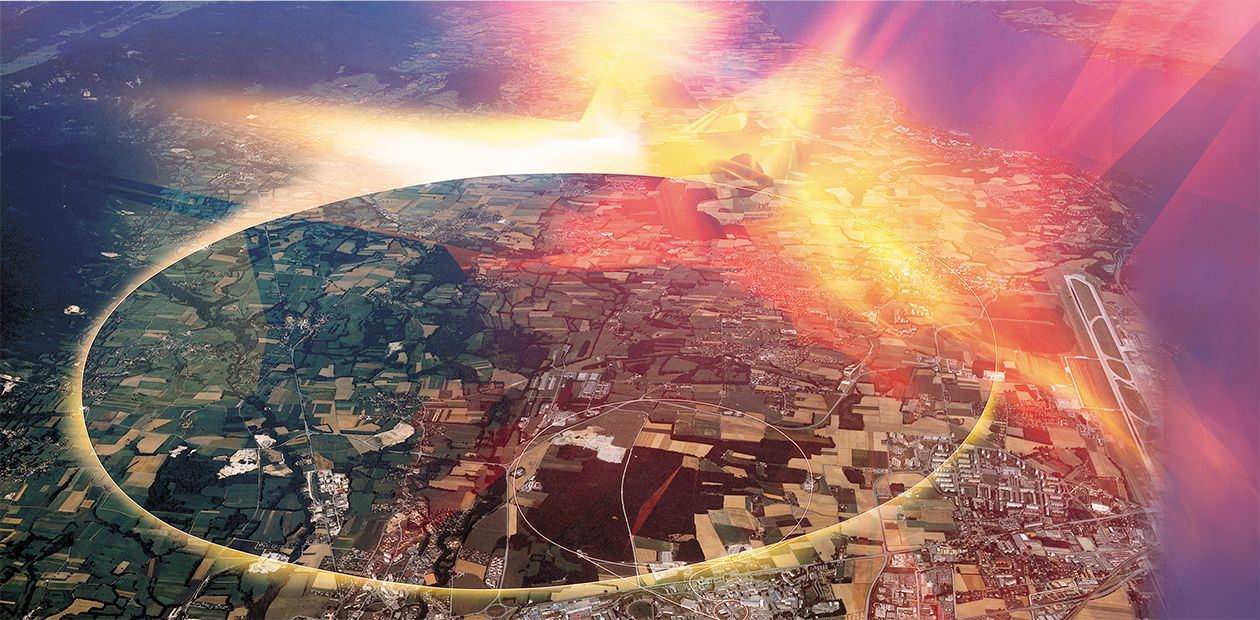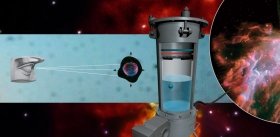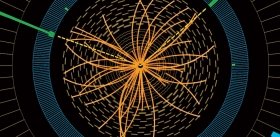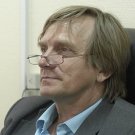Before Blasting off to Microcosm.The Collider is Getting Ready for the Start
At the European Centre for Nuclear Research (CERN) a new elementary particle accelerator called the Large Hadron Collider (LHC) is soon to begin operation. This experimental facility reflects unprecedented development of the science studying the structure of matter at the microscopic level. Man's desire to know how matter is constructed calls for an ever greater energy of colliding particles and ever greater intellectual and financial resources. Dozens of countries and thousands of physicists and engineers participate in this international project.
One of the major LHC scientific tasks is search for the Higgs boson, the missing link of the Standard Model, and new heavy dark matter particles.
We should, however, be ready for the Nature's new surprises. And, ultimately, the unknown that is in store for us can turn out to be the most interesting.
The author of the article about the largest scientific facility ever created by humankind is the member of the CERN Scientific Policy Committee, Doctor of Physics and Mathematics, Corresponding Member of RAS A.E. Bondar. He is also head of the research group of the Institute of Nuclear Physics SB RAS, taking part in the experimental works at one of the LHC detectors - LHCb.
The Large Hadron Collider (LHC) Project (a collider is an accelerator with colliding beams – Ed.) embodies all characteristic features of modern particle physics. Today, as never before, this field of natural science is truly international in character, as it integrates scientific research programs of developed countries. Testing of existing theoretical projections and search and discovery of new fundamental particles and regularities call for the creation of accelerators for maximally possible energies and recording devices capable of processing tremendous data volumes during experiments. Such complicated problems can be solved only by large international collaborations of scientists – specialists in many fields of science and engineering – who possess considerable intellectual and material resources and modern industrial technologies
From the very beginning, Russia’s leading scientific centers have been actively involved in the project. Among these centers are Budker Institute of Nuclear Physics, Institute for Nuclear Research, Petersburg Nuclear Physics Institute, Institute of Theoretical and Experimental Physics, Lebedev Physical Institute, Ioffe Physical Technical Institute, Institute of High-Energy Physics, Russian Scientific Center Kurchatov Institute, and some others. For instance, only INP SB RAS researchers have developed, manufactured, installed, and adjusted 360 dipole magnets and 180 quadrupole magnets for the collider injection channels, ultrahigh-vacuum facilities, an electronic cooler of heavy ions, and numerous other high-technology facilities with a total weight of about 5 000 tons!
The CERN management has repeatedly emphasized that the contribution of Russian scientists, specialists, institutes, and enterprises to the elaboration and execution of the Large Hadron Collider Project is invaluable. It covers not only the logistic support of some key positions, but also the use of the advanced ideas and achievements in particle physics and accelerator engineering presented and developed by our scientists earlier. Naturally, two streets in CERN are named after the Russian physicists V. I. Veksler and G. I. Budker, who made fundamental contributions to the world accelerator science.
Very fast, very deep, and very cold
Up to now, the world’s most powerful accelerator has been the Fermilab proton-antiproton collider (USA). It has achieved an energy of 1 TeV in each beam; that is, up to 2 TeV is released at collision. The CERN Large Hadron Collider will operate with proton beams whose energy is sevenfold larger. The greater the energy, the smaller distances are available for scientists in their investigations of the microworld physics.
What is, in general, the Large Hadron Collider? It is a 27-km ring tunnel made in rocks at a depth of 100 m in which the collider itself is installed. A whole family of accelerators operates together with the LHC. In these accelerators, particles are successively accelerated to velocities maximally close to the speed of light, making 11000 revolutions per second!
Two proton beams are directed towards each other in vacuum chambers of the collider (each beam in its own chamber) and collide at certain places. It is at the points of their meeting that the most interesting thing takes place. The particles are confined in the beams with the help of superconducting magnets. Each dipole – an element of the system of superconducting magnets – weights about 25 tons and has a length of 15 m. It creates a magnetic field with an intensity of over 8 T and can operate only at a temperature of 1.8 K. For this, it is cooled by superfluid liquid helium. The collider has over 1 200 such dipoles, and the system also has 860 quadrupoles and more than 6 000 beam-positioning magnets.
All four-fourths of the way
In addition to the collider (a physical facility where particles collide), experiments require devices to record the products of interaction of these particles. The point is that in collisions of high-energy proton numerous other particles are produced. That is, the energy of initial particles will be used to form new particles, possibly not observed earlier. To understand what takes place at each collision, one needs a complicated facility called the detector.
Four detectors were constructed at LHC. They have their own names: ATLAS (A Toroidal LHC ApparatuS), СMS (Compact Muon Solenoid), LHCb (Large Hadron Collider beauty experiment), and ALICE (A Large Ion Collider Experiment). Why four? This is due to a wide range of scientific problems the researchers are faced with.
One, even a very complicated, set of experimental equipment cannot cover all items of interest. Therefore, it was decided to do the following: to solve problems at the forefront of science using two maximally universal detectors, namely, ATLAS and СMS. This is physics of interaction of elementary particles at maximally small distances (in particular, search for the Higgs boson and dark matter particles). There are two detectors, because it is better to have two facilities with comparable capabilities for the results to be reliable and for independent crosscheck to be possible.
The purpose of a specialized experiment called LHCb is an in-depth study of physical issues related to the modern understanding of symmetry in nature and matter-antimatter symmetry. Although, as we know, this symmetry is only slightly violated, this violation leads to fundamental consequences for the structure of the Universe.
As for ALICE, this detector is designed for experiments with ions, and not with protons. Thus, the major operating regime of the collider is proton-proton collisions; the regime of colliding beams of heavy ions, up to uranium, is also provided.
Standard model of the microworld
Over the last 40 years considerable progress has been achieved in particle physics. What do we know now? What do we not know and would like to learn using the new facility?
There exist four types of fundamental interactions of elementary particles. Electromagnetic interaction is well-known to us from school. Weak interaction is responsible for the decay of long-lived particles, for instance, b-active nuclei. Strong interaction is responsible for the confinement of quarks in hadrons and hadrons in nuclei. And, finally, there is ordinary gravity, which manifests itself very weakly at the scale of the microworld; therefore, it may be neglected for some time.
Modern theory, called the Standard Model, considers three fundamental interactions – electromagnetic, weak, and strong – as related phenomena. Although their properties differ considerably, they are probably a consequence of some more general interaction in nature. The success of a unified description of electromagnetic and weak interactions in the Weinberg-Salam model makes us more and more convinced in this.
Physicists hope that the global theory will relate the strong interaction to the electromagnetic and weak ones. In all likelihood, the behavior of these interactions is universal at much smaller distances than those accessible experimentally. If we know this sophisticated interrelation, it will be possible to describe all phenomena observed in the microworld with a much smaller number of assumptions.
Important achievements in particle physics in the recent decades have been made while testing the theoretical concepts of universality of the electromagnetic and weak interactions. The earlier predicted W- and Z-bosons have been discovered, their properties have been investigated in detail, the t-quark has been detected, etc. These advances have allowed us to basically complete the construction of the Standard Model. However, this picture lacks some final touches, i. e., experimental observations of the Higgs boson.
How much does a “Higgs” weigh?
As it has been mentioned, a search for a Higgs boson is one of the major tasks of the ATLAS and CMS experiments. What kind of particle is it? Why are physicists so much looking forward to its discovery? To answer these questions, let us turn to the origins.
How did the Standard Model develop historically? Quantum electrodynamics completed in late 1940s—early 1950s can be considered the first relativistic theory of (electromagnetic) interaction of elementary particles. It allowed a quantitative description of the interaction of charged leptons (electrons and muons) by the exchange of massless uncharged quanta – photons. The predictive power of the theory turned out to be really fantastic: for instance, the magnetic moment of an electron can be calculated with an accuracy of over 10 significant digits!
To achieve such success, the theory had to solve mathematical problems associated with the calculation of some fundamental quantities. For instance, if corrections to the electron mass are calculated formally, they turn out to be divergent, that is, infinite. If we assume that divergent quantities are finite (due to some effects unknown to us now) and replace them by quantities known experimentally (this operation must be performed only with masses and charges); the rest (the cross sections of processes, anomalous magnetic moments etc.) can be calculated with an accuracy as high as is wished. This approach has led to the creation of the first renormalizable field theory – quantum electrodynamics. Many physicists think that the property of renormalizability is, in general, a fundamental property of any theory aimed at describing nature.
It turned out later that a special class of mathematical models – Yang-Mills field theories – allows the construction of a renormalizable theory for interactions in which massless field quanta can be radiated not only by charges (as in quantum electrodynamics) but also by the fields themselves.
It is well-known that the photon is not charged. It cannot radiate photons – it can interact only with the sources of a photon field, that is, electric charges. If two laser beams are directed towards each other, they fly through each other practically without any interaction. (Light can be scattered by light only because of a high-order interaction – due to the generation of virtual electron-positron pairs).
QUARKS, GLUONS, HADRONS, AND OTHERS
According to the Standard Model, matter consists of 12 fundamental particles that are really elementary, that is, without an inner structure: 6 quarks (d, u, s, c, b, and t) and 6 leptons (electron, muon, -lepton, and 3 types of neutrinos, respectively). Strictly speaking, in reality there are 18 (but not 6) quarks, since they have an additional internal characteristics – the so-called color, which can take 3 different values (6 х 3 = 18). All these particles are fermions and have a spin (intrinsic moment) of 1/2.The number of particle-carriers of interaction is also twelve: 8 massless gluons for strong interaction, 3 heavy bosons (W+, W–, and Z0) for weak interaction, and 1 photon for electromagnetic interaction. In contrast to fundamental fermions, such particles have a single spin and, hence, they are bosons.
Quarks participate in all three types of interactions. Hadrons consist of quarks and are divided into the following two major groups: barions (consisting of three quarks) and mesons (consisting of one quark and one antiquark). The most stable and, therefore, the most naturally widespread barions are the well-known protons and neutrons forming atomic nuclei.
Six types of quarks are grouped in 3 generations: in each generation, one quark has a positive electric 2/3 charge and the other quark has a negative 1/3 charge
The situation described is typical for electrodynamics. At an attempt to construct a theory of weak interaction it turned out that quanta of a weak field can and must radiate themselves. For instance, a W-boson can radiate Z-bosons and vice versa. That is where the Yang-Mills field theory was appropriate. However, the problem was that the carriers of interactions in the Yang-Mills theory are massless. It is known from experiments, however, that the carriers of weak interaction are massive bosons. What should be done for particles-carriers to have mass and, at the same time, preserve renormalizability of the theory? It turned out that this problem can be solved by introducing a new fundamental field, and a quantum of this field is a Higgs boson.
Up to now, Higgs particles have not been observed yet. We can assert from experimental data that the mass of a Higgs boson is probably over 115 GeV. On the basis of theoretical considerations, it does not exceed several TeV. Hence, such particles can and must be generated in the Large Hadron Collider.
How can this particle be distinguished from other known particles? It has special properties. The stronger is the interaction of a Higgs boson with fundamental fields and particles (calibration bosons and quarks), the greater is their mass. If, for instance, the mass of a “Higgs” is greater than the doubled mass of a t-quark (which is 174 GeV), it is most likely that the boson will break into a t-quark and a t-antiquark. The properties of a Higgs boson will be different (but quite definite) depending on its mass. And if such a particle exists in nature, we will certainly find it.
Is dark matter supersymmetric?
Even after the discovery of the Higgs boson the Standard Model cannot be considered completed. One of its important extensions is supersymmetry. This modern theory removes some internal problems of the Standard Model and, at the same time, solves some other important problems; in particular, it explains the presence of dark matter in the Universe.
The theory of supersymmetry suggests the existence of a whole class of new fundamental particles. A superpartner, that is, a particle-relative with a different mass and different properties, is assigned to each known particle of the Standard Model. A boson corresponds to each fermion, and a fermion corresponds to each boson. Such particles have not been observed experimentally, probably due to the lack of energy.
The supersymmetric sector can be considered to have the lightest and, therefore, stable particle not charged electrically. It cannot break up into ordinary particles, just as the proton is the lightest baryon and does not break up into any other particles, since the baryon charge is conserved.
It is assumed that all supersymmetric particles which originated at the first moments of the Big Bang, finally broke up into ordinary particles and the lightest neutral supersymmetric particles. These particles practically do not interact with anything but the gravitational field. It is quite possible that dark matter blobs observed by astrophysicists consist just of such particles.
For some time the temperature of the Universe was high and supersymmetric particles were in thermodynamic equilibrium with the rest of the matter. Knowing the generation cross section, the lifetime, and the probability of decay, we can calculate how many particles must have remained since that time. In the same way as today theorists can calculate how much hydrogen and helium and how many protons and photons must have resulted from the Big Bang. Thus, one can determine from the microscopic properties of supersymmetric particles that will be detected by us at LHC how much dark matter the Universe must have if its source is supersymmetry. And the actual mass of the dark matter is known from astronomical observations.
And what if no supersymmetric particles are found with the ATLAS and СMS detectors? This will only mean that a whole class of models very popular now owing to their inherent beauty will be actually not used. Science has no other way of testing the validity of a theory than performing critical experiments.
“ALICE” quark-gluon wonders
There are certain expectations associated with superhigh energy of ion collisions at the ALICE detector. Although ATLAS and СMS will probably also operate in the ion mode, the capabilities of these detectors are not optimized for investigations of such processes. A peculiarity of ion collisions is that they are relatively rare (due to a small density of ion beams), but a large number of secondary particles – several thousands or even tens of thousands – is generated in each of them.
What happens when ions collide? The kinetic energy of primary particles (and if an ion has about 100 nucleons, this energy is about several hundred TeV) is transformed into the temperature of hadrons; that is, very fast heating of nuclear matter takes place. It is assumed that in this case conditions for phase transitions are created. Then the strongly heated nuclear matter scatters and cools down, turning finally into mesons, baryons, and other particles. By investigating the final products one can obtain information about the processes that took place with the nuclear matter at such extreme conditions.
What kind of processes are these? It is well-known that protons and neutrons consist of quarks. Quarks are confined in nucleons by means of interaction with gluons. Gluons are carriers of strong interactions. According to modern concepts, quarks cannot exist in the free state. If we try, so to say, to get one quark from a proton or a neutron, we will not be able to do this, because the fields that hold the quark become so strong that a quark-antiquark pair is generated from the vacuum, and we will have not a quark but a meson.
There exists a hypothesis that at high density and temperature of nuclear matter nucleons melt, so to speak. In this case it is impossible to extract individual neutrons and protons and the nuclear matter itself looks like the bound state of a large number of quarks and gluons. This state is called quark-gluon plasma.
Repeated attempts have been made to find the quark-gluon plasma. There is hope that LHC, namely, the detector ALICE, will allow obtaining this exotic state of matter and investigating its physical properties.
Zestful B-mesons
Physics of B-mesons is among important tasks of LHC. B-mesons are particles made of a b-quark and a light antiquark (u, d, or s). The major point is that this meson has a b-quark – the heaviest quark with charge 1/3 (recall that the six known quarks are grouped in three generations: in each generation, as a rule, a heavier quark has a positive electric 2/3 charge and a lighter quark has a negative 1/3 charge).
What makes these mesons interesting? Their properties make it possible to understand the matter-antimatter symmetry violation.
The Universe is asymmetric with respect to the matter and antimatter. Almost all the matter that is observed consists of protons, neutrons, and electrons, and the amount of antimatter is very small. On the other hand, the interactions of particles and antiparticles investigated experimentally are extremely symmetric. As of the beginning of the 21st century, the only phenomenon that violated the symmetry between particles and antiparticles at the microscopic scale was the well-known combined parity (CP) violation in the decay of long-lived neutral kaons. Sometimes (rarely!) kaons decay with the violation of CP-symmetry (CP is successive use of the following two transformations: C denotes the change of all charges for the opposite ones, and P is the mirror reflection, that is, the change of vectors for the opposite ones).
In modern theory, it is the CP-transformation that turns particles into antiparticles. And it turns out that in the Standard Model the CP-symmetry is already broken. This fact allows us to believe that the asymmetry observed in the Universe is not accidental. At the time of the world’s origin, the amounts of matter and antimatter were equal. In the process of evolution, however, as a result of the particle-antiparticle interaction, antiparticles disappeared and there remained only particles from which stars, galaxies, and life formed later.
HIERARCHIC COMPUTER SYSTEM GRID
A special system called GRID has been specially developed to store and process experimental data coming from the LHC detectors. It is a computing environment made up of a large number of computers (over 20 000 processor cores) connected by high-speed communication lines. This geographically distributed infrastructure combines resources: processors, long-term and main memory, data warehouses and bases, as well as networks, access to which can be obtained by users regardless of their location.For data flow optimization, the GRID system is divided into several tiers. The zero tier located at CERN is responsible for the storage of initial information and its transmission to national centers.
The first tier distributed among national centers reconstructs physical events. Here, physical information (exit angles, pulses, and particle types) is extracted from the initial information (signal amplitudes, times).
The second tier consists of computer clusters at universities and institutes to investigate certain events for specific scientific problems and numerical simulation of the experiment.
And, finally, the third tier - the resources of work groups – is used to access the experimental data, visualize, and temporarily store the results of analysis.
To understand the details of this process, it is important to thoroughly investigate the particle-antiparticle symmetry violation. B-mesons allow us to do this. The purpose of a specialized LHC detector called LHCb is to study the effect of CP-symmetry violation in decays of B-mesons. And a record large number of B-mesons will be generated in collisions of proton beams at LHC.
Incidentally, all four detectors operate simultaneously. Such B-mesons will also be generated both at ATLAS and CMS. While at these facilities information about such events will mostly be lost, LHCb is optimized for such purposes. On the other hand, recording Higgs bosons at LHCb is difficult and, maybe, even impossible.
Global flow
What is special about the Large Hadron Collider is a qualitatively new scale of the information flow and an unusually large number of people participating in the experiments.
Thousands of specialists are engaged in each of the four projects and all of them must have access to the data. They certainly cannot reside in CERN; in this case they will have nowhere to live. Therefore, it has been organized as follows: each participant working at their own institute or university has access to the database of the experiment and, besides, provides their computational resources to all collaborators. The data analysis and processing are distributed worldwide via a network made up of a few thousand (!) computers. Any member of the collaboration running a program has no idea in which computer the process is taking place – the system called GRID distributes the resources itself.
LHC is planned to work round-the-clock; about 10 months a year; beams will be continuously colliding and data will be continuously recorded. The process must be organized so that the data are processed immediately after the data flow arrives from detectors. Breaks are provided only for maintenance and repair works.
How is all this organized in reality? A lot of events – tens of millions per second! – occur at the places where beams meet! Uninteresting events are immediately filtered out by a multi-level trigger system of the detectors (which decreases the data flow by almost 6 orders of magnitude), and potentially relevant events are recorded on magnetic carriers for long-term storage and subsequent processing. These data are catalogued in a certain way; each detector has its own database.
For the purpose of optimization, the GRID system is divided into several so-called tiers. The zero tier located at CERN is responsible for the storage of initial information and its transmission to national centers. Before physics of a phenomenon can be analyzed, the initial information directly measured by the device (signal amplitudes, times) must be turned into physical parameters (particle types, pulses, energies, and exit angles). This is performed in national centers of the first tier. Scientific analysis starts at the next tier.
The routine work in experimental particle physics lies in the fact that, unfortunately, the overwhelming majority of events is of no interest. An extremely small part of events related to the scientific problem of interest to the researcher is chosen for investigation; it is placed in a separate catalog. Then the filtered information is analyzed in different ways to obtain the final physical results. For instance, one can search for particles not observed earlier; determine the probabilities of occurrence of certain events, etc.
Then, a scientific article is written. It is certainly discussed by the collaboration, because the entire team participating in the experiment is responsible for the authenticity of the results. The article is sent to a journal and becomes accessible to the scientific community only after coordination.
The first proton beams were successfully injected into LHC last September. However, as it often happens in science, at the start of the new facility with the greatest possible technical capabilities ever achieved by the humankind did not go smoothly. The accident happened during tests of major magnets at the maximal field after a few days of successful operation: as a result of uncontrolled superconductivity loss, a part of the facility was damaged.
The accident has revealed some technical defects in the constructions of the accelerator magnetic elements. Their reasons have been thoroughly analyzed, and measures aimed at avoiding such accidents in the future have been worked out. It is expected that by the end of 2009 all necessary corrections will be made in the construction and the collider will resume its operation.
In conclusion, it should be noted that projects like the Large Hadron Collider are certainly not executed solely for the sake of records. To bring such colossal resources together, there must be a clear idea of the prospects: what new information will we have? In this article, I have tried to show that physicists do have such an understanding. We should, however, be ready for the Nature’s new surprises. And, ultimately, the unknown that is in store for us can turn out to be the most interesting.
References
Vainshtein A. I., Zakharov V. I., Shifman M. A. Higgs Particles // Usp.fiz. nauk – 1980. – Vol. 131. – No.8.
Dremin I. M. Physics on Large Hadron Collider // Usp.fiz. nauk. – 2009. – Vol. 179. – No.6.
Dremin I. M., Kaidalov A. B. Quantum Chromodynamics and Phenology of Strong Interactions // Usp.fiz. nauk. – 2006. – Vol. 176. – No. 3.















